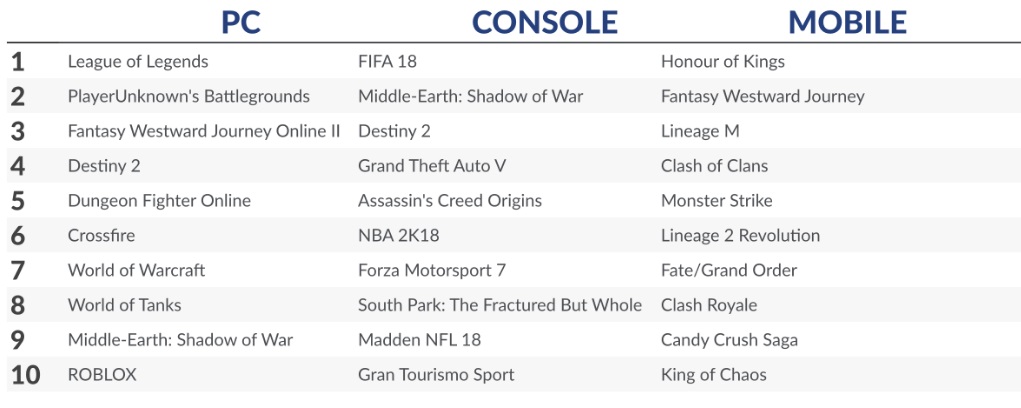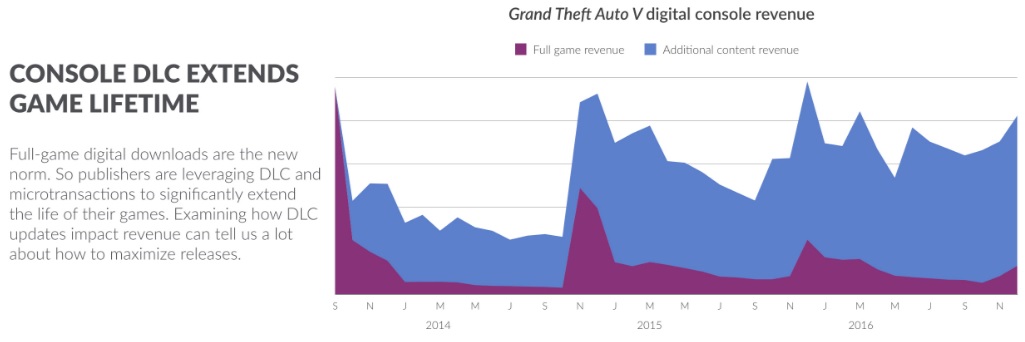Revenue from digital game sales has increased 15% since 2016
Revenue from digital game sales has increased 15% since 2016
When looking at the top 10 sales chart from SuperData, it is clear to see that this rise can be credited to multiplayer games for the most part. Single-player games like Assassin’s Creed Origins, Sout Park: The Stick of Truth and Middle-Earth: Shadow of War are all high on the sales list for consoles.Â
2017 has also seen an increase of digital-only game releases, with Player Unknown’s Battlegrounds being a prime example of this PC and Hellblade: Senua’s Sacrifice acting as an example of this on PS4 and PC. Â
Looking at these lists, we can see that the majority of the titles shown have some form of Microtransactions system integrated into the game. FIFA 18 sits on the top of the console list, in part thanks to the game’s divisive, yet highly popular Ultimate Team system.Â
 Â
(Charts from SuperDATA Research)
The graph below showcases the digital revenue of Grand Theft Auto V between 2014 and 2016, highlighting how much revenue is generated from microtransactions for the title. This income has allowed Rockstar Games to develop a lot of free online content for the title since its release and explains why the developer feels no need to create new single player content for the game. Â
SuperData’s statistics showcase how important microtransactions are for maintaining a game’s profitability in the long term, which is terrible news for those of us who would prefer to avoid such monetisation systems.Â
When looking at this data, it is unsurprising that the games industry is moving in its current direction. Player retention is now a vital metric for video game developers, keeping players interested with content updates that are backed up with a monetisation system that can earn money months or even years after a game’s initial launch.Â
Previously, a game generated most of its revenue at launch, with the invention of digitally downloadable DLC allowing developers to get secondary payments from their players. Microtransactions systems take things a step further, allowing a sizable amount of revenue to be generated consistently over an extended period. This financial stability makes these monetisations systems particularly attractive to big publishers, who are in the business of making money rather than making games. Â
You can join the discussion on this year’s increase in digital games revenue on the OC3D Forums.Â
Revenue from digital game sales has increased 15% since 2016
When looking at the top 10 sales chart from SuperData, it is clear to see that this rise can be credited to multiplayer games for the most part. Single-player games like Assassin’s Creed Origins, Sout Park: The Stick of Truth and Middle-Earth: Shadow of War are all high on the sales list for consoles.Â
2017 has also seen an increase of digital-only game releases, with Player Unknown’s Battlegrounds being a prime example of this PC and Hellblade: Senua’s Sacrifice acting as an example of this on PS4 and PC. Â
Looking at these lists, we can see that the majority of the titles shown have some form of Microtransactions system integrated into the game. FIFA 18 sits on the top of the console list, in part thanks to the game’s divisive, yet highly popular Ultimate Team system.Â
 Â
(Charts from SuperDATA Research)
The graph below showcases the digital revenue of Grand Theft Auto V between 2014 and 2016, highlighting how much revenue is generated from microtransactions for the title. This income has allowed Rockstar Games to develop a lot of free online content for the title since its release and explains why the developer feels no need to create new single player content for the game. Â
SuperData’s statistics showcase how important microtransactions are for maintaining a game’s profitability in the long term, which is terrible news for those of us who would prefer to avoid such monetisation systems.Â
When looking at this data, it is unsurprising that the games industry is moving in its current direction. Player retention is now a vital metric for video game developers, keeping players interested with content updates that are backed up with a monetisation system that can earn money months or even years after a game’s initial launch.Â
Previously, a game generated most of its revenue at launch, with the invention of digitally downloadable DLC allowing developers to get secondary payments from their players. Microtransactions systems take things a step further, allowing a sizable amount of revenue to be generated consistently over an extended period. This financial stability makes these monetisations systems particularly attractive to big publishers, who are in the business of making money rather than making games. Â
You can join the discussion on this year’s increase in digital games revenue on the OC3D Forums.Â





